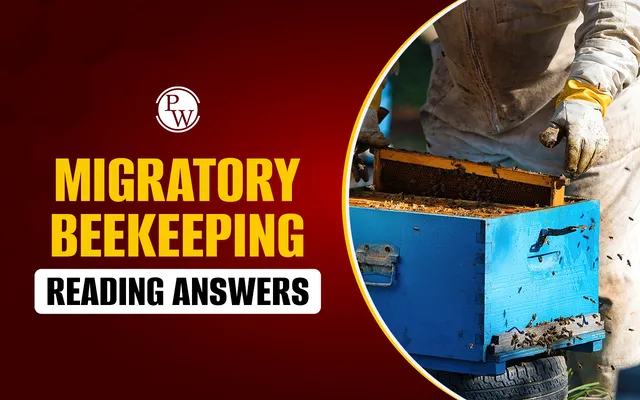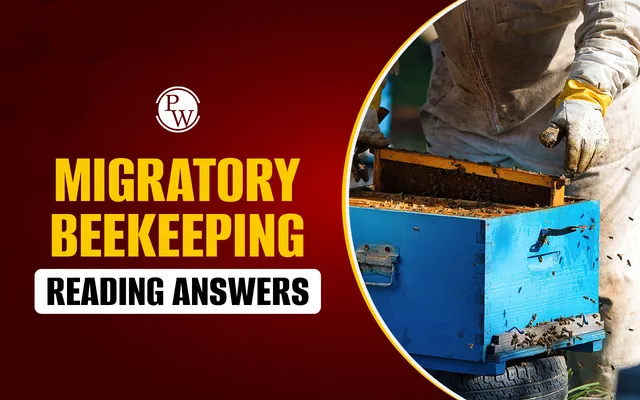

Migratory Beekeeping Reading Answers passage explains how apiarists move hives to follow blooms and increase honey production. In this migratory beekeeping reading passage, honeybees perform pollination while producing honey for farmers. Students practicing migratory beekeeping reading answers can learn about bee migration patterns, hive management, and seasonal movements.
The passage is ideal for migratory beekeeping reading questions or bee migration IELTS reading exercises, as it combines factual details with process descriptions. Understanding this honeybees IELTS passage helps learners handle multiple choice questions in IELTS Reading, sentence completion, and other IELTS Reading question types, improving overall IELTS Reading score and band performance.
Migratory Beekeeping Reading Passage
This migratory beekeeping reading passage explains how apiarists move hives to follow flowering seasons. It covers bee migration, honey production, and pollination. Learners can use this honeybees IELTS passage to understand seasonal hive movements and the role of bees in agriculture, making it useful for IELTS Reading practice.
Migratory Beekeeping
To eke out a permanent living from their honey bees, about fifty percent of the nation’s 2,000 trade apiarists stop post each spring, wandering north to find more flowers for their bees. Apart from turning floral nectar into honey, these diligent insects also pollinate crops for farmers-for a fee. As autumn approaches, the apiarists pack up their hives and go south to climb for pollination agreements in hot spots like California's fecund central valley.
Of the 2,000 business apiarists in the United States about half relocate. This pays off in two processes: moving North in the summer and South in the winter lets bees toil lengthy blooming periods, making more honey and money for their custodian. Second, apiarists can transfer their hives to farmers who need bees to breed their crops. Every spring a migrant apiarist in California may transfer up to 160 million bees to flowering fields in Gopher State and every winter his family may drag the hives back to California, where farmers will hire and charge the bees to breed almond and cherry trees.
Migrant beekeeping is nothing new. The early Egyptians moved kaolin hives, doubtless on barges, down the Nile to follow the bloom and nectar flow as it transferred to Cairo. In the 1880s North American apiarists tested with the same plan, moving bees on rafts along the Mississippi and on waterways in Florida, but their lighter, wooden hives kept falling into the water. Other keepers tried the coerce and horse-drawn wagons, but that did not demonstrate practicality. Not up to the 1920s when cars and trucks became affordable and roads improved, did migrant beekeeping begin to take off.
For the Californian apiarist, the breeding period begins in February. At this time, the honeycombs are in specific demand by farmers who have almond copse; they need two hives an acreage. For the three-week-long bloom, apiarists can rent out their hives for $32 each. It’s a windfall for the bees too. Most people contemplate almond honey being excessively bitter to eat so the bees get to retain it for themselves.
By March it is time to transfer the bees. It can take seven nights to pack the 4,000 or so hives that an apiarist may own. These are not transfers in midday because excessively of the bees would end up vagrant. But at night, the hives are piled onto wooden stretchers in sets of four, and raised onto a truck. It is not compulsory to wear gloves or an apiarist's mask because the hives are not being opened and the bees are almost silent. Just in case some are still lively, bees can be placated with a few gusts of smoke popped into each hive’s tapered entryway.
In their new place, the apiarist will pay the agronomist to allow his bees to feed in such places as an orange copse. The honey manufactured here is scented and sweet and can be sold by the apiarist. To motivate the bees to construct as much honey as possible during this time, the apiarist opens the hives and heaps additional boxes called supers on top. These short-term hive add-on hold frames of vacant comb for the bees to fill with honey. In the offspring hall below, the bees will store honey to eat later. To avert the queen from creeping up to the top and putting down eggs, a screen can be put in the middle of the offspring and the supers. After three weeks the honey can be congregated.
Disgusting scent chemicals are frequently used to irritate bees and drive them down into the hive’s to bottom boxes, leaving the honey-filled supers roughly bee free. These can then be accomplished by the hive. They are massive with honey and might be considered to be 90 pounds each. The supers are taken to the storeroom. In the extracting room, the frames are lilted out and let down into an “unseal” where rotating cutlass shave away the wax that covers all the cell. The unsealed frames are put in a whirligig filled to volume with 72 frames. A switch is overturned and the frames begin to rotate at 300 revolutions per minute; diffusive power throws the honey out of the combs. At last the honey is transferred into barrels for export.
After this, roughly one-fourth of the hives weakened by sickness,mites or a declining or dead queen, will have to be put back. To produce new colonies, a healthy double hive, be full of bees, can be split into two various boxes. One half will hold the queen and a young, earlier breed queen can be put in the other half, to make two hives from one. By the time the flowers bloom, the new queen will be putting down eggs, filling each hive with young toilers bees. The apiarist's household will then wander with them to their summer place.
Migratory Beekeeping Reading Questions
The migratory beekeeping reading questions focus on comprehension of bee migration, hive management, and honey production processes. These questions help students practice bee migration IELTS reading strategies, such as identifying key facts, understanding sequences, and answering multiple-choice or sentence completion questions effectively.
Multiple Choice Questions (MCQs)
Answer these Multiple Choice Questions (MCQs):
1. Why do about half of the 2,000 apiarists in the U.S. move their hives each year?
A) To avoid pests
B) To follow blooming flowers
C) To reduce transport costs
D) To sell honey directly to consumers
2. Which crop in California requires two hives per acre?
A) Cherry trees
B) Almond trees
C) Orange groves
D) Wheat fields
3. What was a major limitation of early North American migrant beekeeping in the 1880s?
A) Bees were aggressive
B) Wooden hives were too light and fell into waterways
C) Farmers refused to hire bees
D) Bees produced poor-quality honey
4. When do apiarists typically move hives to new locations?
A) Midday
B) Nighttime
C) Early morning
D) Afternoon
5. What is the purpose of adding supers to hives?
A) To store pollen separately
B) To allow bees to produce more honey
C) To trap queen bees
D) To make hive transport easier
True/False/Not Given Questions
Answer these True/False/Not Given questions:
6. Migratory beekeeping began in the 1920s when trucks became affordable.
7. Most apiarists wear gloves and masks while transferring hives.
8. Bees are used to pollinate crops for a fee.
9. All hives survive the migration without any issues.
10. Almond honey is usually collected by humans during the bloom.
Sentence Completion Questions
Here are Sentence Completion Questions:
11. To motivate bees to produce honey, apiarists add __________ to the hives.
12. Early Egyptians moved hives along the __________ to follow the nectar flow.
13. About __________ hives may be packed in a single apiarist’s operation.
14. Weak or sick hives are often __________ or split to produce new colonies.
15. Honey is extracted from frames using a __________ that spins at high speed.
Migratory Beekeeping Reading Answers
The migratory beekeeping reading answers provide clear solutions to questions based on the passage. Reviewing these answers helps learners confirm understanding of bee migration patterns, hive operations, and pollination. This section supports preparation for honeybees IELTS passage exercises and improves overall confidence in IELTS Reading tests.
| Migratory Beekeeping Reading Answers | |||
| No. | Question | Answer | Explanation |
| 1 | Why do about half of the 2,000 apiarists in the U.S. move their hives each year? | B) To follow blooming flowers | They migrate north or south to access continuous nectar and extend honey production. |
| 2 | Which crop in California requires two hives per acre? | B) Almond trees | The passage states farmers need two hives per acre for almond pollination. |
| 3 | What was a major limitation of early North American migrant beekeeping in the 1880s? | B) Wooden hives were too light and fell into waterways | Early attempts failed due to lightweight wooden hives falling in rivers. |
| 4 | When do apiarists typically move hives to new locations? | B) Nighttime | Bees are quieter at night, reducing escape risks during transport. |
| 5 | What is the purpose of adding supers to hives? | B) To allow bees to produce more honey | Supers are additional boxes to give bees more space to store honey. |
| 6 | Migratory beekeeping began in the 1920s when trucks became affordable. | True | The passage mentions beekeeping expanded after trucks and better roads became available. |
| 7 | Most apiarists wear gloves and masks while transferring hives. | False | Gloves/masks are not compulsory as bees are mostly calm during night transfers. |
| 8 | Bees are used to pollinate crops for a fee. | True | Farmers hire apiarists for crop pollination in addition to honey production. |
| 9 | All hives survive the migration without any issues. | False | Some hives weaken due to sickness, mites, or dead queens. |
| 10 | Almond honey is usually collected by humans during the bloom. | False | Bees mostly retain almond honey; humans do not harvest it during bloom. |
| 11 | To motivate bees to produce honey, apiarists add __________ to the hives. | Supers | Additional boxes (“supers”) are added for honey production. |
| 12 | Early Egyptians moved hives along the __________ to follow the nectar flow. | Nile | Egyptians transported hives along the Nile to access blooms. |
| 13 | About __________ hives may be packed in a single apiarist’s operation. | 4,000 | The passage mentions an apiarist may own ~4,000 hives. |
| 14 | Weak or sick hives are often __________ or split to produce new colonies. | Replaced / split | Sick or weak hives are replaced; strong hives are split to create two. |
| 15 | Honey is extracted from frames using a __________ that spins at high speed. | Centrifuge | Frames are placed in a centrifuge (“whirligig”) spinning at 300 rpm to extract honey. |
Guidance to PW IELTS Prep
IELTS Online Courses is a great initiative Physics Wallah took to help IELTS aspirants better prepare for the exam. Follow our below pages to learn more about the IELTS exam.| IELTS Reading Band Score | IELTS Listening Band Score |
| IELTS Speaking Band Score | IELTS Writing Band Score |
Migratory Beekeeping Reading FAQs
What is migratory beekeeping?
Why do apiarists move their hives at night?
How do apiarists increase honey production during blooms?
Which crops commonly hire bees for pollination?
How is honey extracted from the hives?













